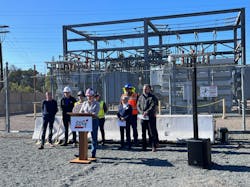SDG&E Adds Energy Storage to Substation, Boosting Grid Resilience
San Diego Gas & Electric (SDG&E) broke ground on the Clairemont Microgrid, one of four such projects based at its existing substations. Each microgrid is paired with energy storage, with the four projects bringing an additional 39 MW of battery capacity to the region.
As part of its commitment to reach net zero and strengthen grid reliability, SDG&E has been rapidly expanding its energy storage portfolio. It currently has 95 MW of utility-owned energy storage online, with another 200+ MW in development.
Once complete, the Clairemont Microgrid will be able to provide backup power to Fire Station 36, Balboa Branch Library/Cool Zone and local schools such as Lafayette Elementary, Sequoia Elementary, Innovation and CPMA Middle Schools and Madison High School.
During the 10-day heatwave around Labor Day in September, energy storage, in addition to energy conservation efforts, helped California avoid rotating outages. California has dramatically increased investment in energy storage in recent years, and now has more than 4,400 MW of batteries.
Batteries provided an estimated 4% of the electricity supply during peak demand to help avert rotating outages in September. Within SDG&E’s service territory, utility-scale battery storage systems – utility and third party-owned – served as much as 7% of the regional load during peak hours of the heatwave.
At today’s groundbreaking event for the Clairemont Microgrid at SDG&E’s substation in the same neighborhood, Romero was joined by San Diego Councilmember Jennifer Campbell (District 2), as well as local business and labor leaders.
Microgrids are small-scale grids that can operate independent of or parallel to the larger regional grid to keep critical community facilities powered during unexpected outages. When a microgrid is powered by battery storage, it produces zero emissions. Battery storage works by capturing renewable energy like wind and solar when they are abundant during the day, then sending that energy back to the grid when it is needed, such as at night when the sun has set or when energy supply is tight during adverse weather events.
About the Author
T&D World Staff
Content Team
Nikki Chandler
Group Editorial Director, Energy
[email protected]
Jeff Postelwait
Managing Editor
[email protected]
Christina Marsh
Senior Editor
[email protected]
Ryan Baker
Associate Editor
[email protected]
Amy Fischbach
Electric Utility Operations
[email protected]
Rich Maxwell
Community Editor
[email protected]
Gene Wolf
Technical Editor
[email protected]
